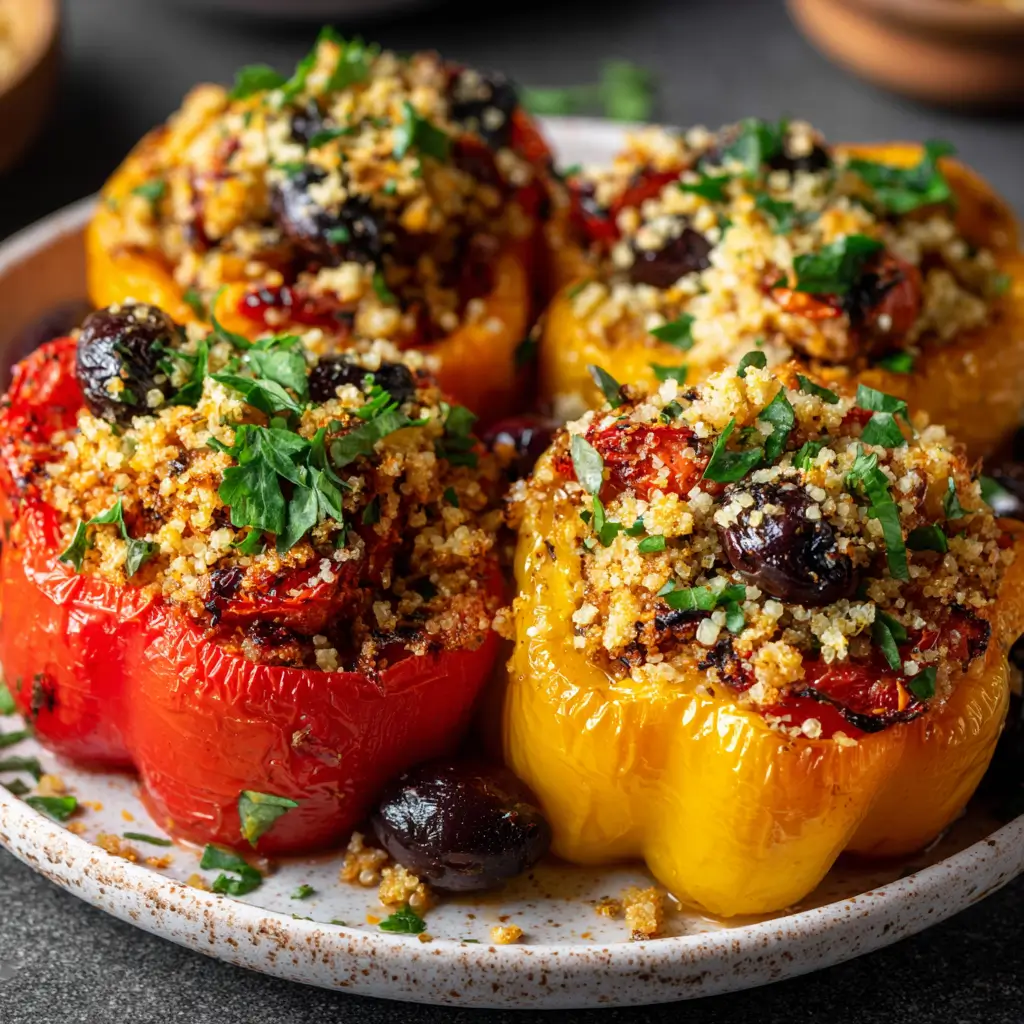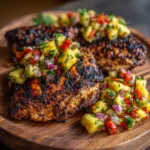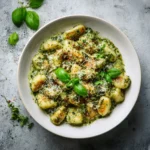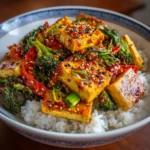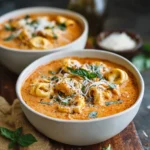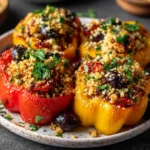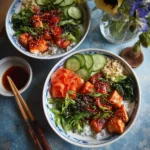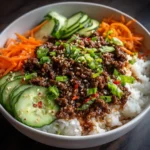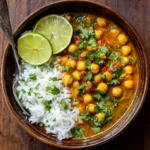Vegan Stuffed Peppers: A Hearty, Wholesome Plant-Based Delight
Introduction
Vegan stuffed peppers are a vibrant, nutritious, and satisfying meal that brings together the natural sweetness of bell peppers with a rich, flavorful filling made entirely from plant-based ingredients. Whether you’re a long-time vegan, transitioning to a plant-powered diet, or simply looking for a delicious meatless dinner option, this dish is sure to become a staple in your kitchen. Packed with whole grains, legumes, vegetables, and aromatic herbs and spices, vegan stuffed peppers offer a balanced blend of protein, fiber, and essential nutrients—all wrapped in a colorful, edible package. This recipe is not only wholesome but also visually stunning, making it perfect for weeknight dinners, meal prep, or even serving guests at a dinner party.
The History
Stuffed peppers have a long and diverse culinary history, with roots stretching across various cultures around the world. Originating in Eastern Europe, the Balkans, and the Middle East, traditional versions often included ground meat, rice, and tomatoes simmered in sauce. In countries like Greece (known as gemista), Turkey (dolma), Hungary, and Spain, variations of stuffed vegetables—including peppers—have been cherished for generations. Over time, as vegetarianism and veganism gained popularity, these classic recipes evolved to exclude animal products while maintaining their depth of flavor and heartiness. The vegan adaptation of stuffed peppers emerged as a creative and compassionate alternative, substituting meat with lentils, quinoa, mushrooms, beans, or textured vegetable protein. Today, vegan stuffed peppers reflect a global fusion of traditions, emphasizing sustainability, health, and bold taste.
Ingredients Breakdown
The magic of vegan stuffed peppers lies in the harmony of its components. Each ingredient plays a crucial role in building layers of flavor, texture, and nutrition:
- Bell Peppers: Choose large, firm bell peppers (red, yellow, orange, or green) for optimal stuffing capacity and natural sweetness when baked.
- Quinoa or Brown Rice: Provides a hearty, protein-rich base. Quinoa is a complete protein, while brown rice adds chewiness and fiber.
- Lentils or Black Beans: Excellent sources of plant-based protein and iron. Cooked brown or green lentils hold their shape well, while black beans add creaminess.
- Onion and Garlic: Sautéed until fragrant, they form the aromatic foundation of the filling.
- Tomatoes: Fresh diced tomatoes or canned crushed tomatoes lend moisture and acidity, enhancing overall flavor.
- Vegetable Broth: Used to cook the grains and enrich the stuffing mixture, adding depth without animal products.
- Olive Oil: A heart-healthy fat used for sautéing and boosting richness.
- Spices: Cumin, smoked paprika, oregano, thyme, and black pepper contribute warmth, earthiness, and complexity.
- Nutritional Yeast: Adds a cheesy, umami flavor and B-vitamins—perfect for enhancing savoriness without dairy.
- Spinach or Kale: Leafy greens boost vitamins A, C, and K, and add color and freshness to the mix.
- Tomato Sauce: For baking the peppers in—a tangy, savory environment that keeps them moist and flavorful.
- Optional Toppings: Fresh cilantro, parsley, avocado slices, jalapeños, or vegan cheese shreds can elevate the final presentation.
Step-by-Step Recipe
- Prepare the Peppers: Preheat oven to 375°F (190°C). Slice the tops off the bell peppers and remove the seeds and membranes. Lightly brush the outside with olive oil and place them upright in a baking dish. Blanch them in boiling water for 3–4 minutes to soften slightly, then drain and set aside.
- Cook the Grain: In a saucepan, combine 1 cup quinoa (or brown rice) with 2 cups vegetable broth. Bring to a boil, reduce heat, cover, and simmer for 15 minutes (quinoa) or 40 minutes (rice) until tender. Fluff with a fork and set aside.
- Sauté the Aromatics: In a large skillet, heat 2 tablespoons olive oil over medium heat. Add 1 chopped onion and 3 minced garlic cloves. Cook for 5–6 minutes until translucent and fragrant.
- Add Vegetables and Spices: Stir in 1 cup diced tomatoes, 1 cup chopped mushrooms (optional), and 2 cups chopped spinach or kale. Cook until greens are wilted, about 3–4 minutes. Season with 1 tsp cumin, 1 tsp smoked paprika, 1/2 tsp dried oregano, 1/2 tsp thyme, salt, and black pepper to taste.
- Combine the Filling: In a large bowl, mix the cooked grain, sautéed vegetables, and 1.5 cups cooked lentils or black beans. Add 2–3 tbsp nutritional yeast and adjust seasoning. Stir well until evenly combined.
- Stuff the Peppers: Spoon the filling into each blanched pepper, pressing gently to pack. Place them snugly in a baking dish. Pour 1 cup tomato sauce or marinara around the base of the peppers (not over the top to prevent sogginess).
- Bake: Cover the dish with aluminum foil and bake for 30 minutes. Uncover and bake for an additional 15–20 minutes until peppers are tender and slightly caramelized at the edges.
- Garnish and Serve: Let cool slightly, then top with fresh herbs, avocado, or a drizzle of tahini or hot sauce. Serve warm.
Tips
- Pepper Selection: Look for peppers with flat bottoms so they stand upright without tipping over.
- Pre-Cooking Peppers: Blanching helps reduce baking time and ensures tender peppers without overcooking the filling.
- Firm Fillings: Avoid overly wet mixtures. If your filling is too moist, cook it longer in the skillet to evaporate excess liquid.
- Make Ahead: Prepare the filling up to 2 days in advance and store in the fridge. Stuff and bake just before serving.
- Freezing: Fully assembled (but unbaked) stuffed peppers can be frozen. Wrap tightly and bake from frozen, adding 15–20 minutes to cooking time.
- Even Cooking: Use a baking dish that fits the peppers snugly to prevent them from falling over during baking.
- Flavor Boost: Add a splash of balsamic vinegar or lemon juice to the filling for brightness.
Variations and Customizations
Vegan stuffed peppers are incredibly versatile. Here are some creative twists to keep the dish exciting:
- Mexican-Inspired: Use black beans, corn, diced green chilies, cumin, chili powder, and lime juice. Top with avocado and cilantro.
- Mediterranean Style: Add chopped sun-dried tomatoes, olives, capers, artichoke hearts, and fresh basil. Use bulgur wheat instead of quinoa.
- Thai Fusion: Mix in red curry paste, coconut milk, and edamame. Garnish with Thai basil and crushed peanuts.
- Breakfast Version: Stuff with tofu scramble, sautéed veggies, and potatoes. Bake and serve with salsa.
- Protein-Packed: Add crumbled tempeh, textured vegetable protein (TVP), or walnuts for extra texture and protein.
- Low-Carb Option: Replace grains with finely chopped cauliflower rice or shredded Brussels sprouts.
- Spicy Kick: Include diced jalapeños, chipotle peppers in adobo, or a pinch of cayenne.
- Cheesy Flavor (Vegan): Stir in vegan cheese shreds or a cashew cream sauce before baking.
Health Considerations and Nutritional Value
Vegan stuffed peppers are a powerhouse of nutrition, offering a balanced profile of macronutrients and micronutrients. A typical serving (one stuffed pepper) provides approximately:
- Calories: 300–400 kcal (depending on ingredients)
- Protein: 12–18g (from lentils, beans, quinoa, and nutritional yeast)
- Fiber: 10–15g (supports digestion and satiety)
- Fat: 8–12g (mainly heart-healthy monounsaturated fats from olive oil)
- Carbohydrates: 50–60g (complex carbs from whole grains and vegetables)
This dish is naturally low in saturated fat and cholesterol-free. It’s rich in:
- Vitamin C: From bell peppers—boosts immunity and skin health.
- Vitamin A: Supports vision and immune function.
- Folate and Iron: Essential for energy metabolism and red blood cell production.
- Antioxidants: Lycopene (in tomatoes), beta-carotene (in peppers), and polyphenols help combat oxidative stress.
For individuals managing diabetes, this meal offers a moderate glycemic load, especially when using low-GI grains like quinoa or barley. Those with gluten sensitivities can enjoy this dish safely, provided all ingredients (especially broth and sauces) are certified gluten-free. The high fiber content aids in blood sugar regulation and promotes gut health.
Ingredients
- 4 large bell peppers (any color)
- 1 cup uncooked quinoa (or brown rice)
- 2 cups vegetable broth
- 1 tablespoon olive oil (plus more for brushing)
- 1 medium onion, diced
- 3 garlic cloves, minced
- 1 cup cooked brown or green lentils (or canned, drained)
- 1 cup diced tomatoes (fresh or canned)
- 2 cups fresh spinach or kale, chopped
- 1 teaspoon ground cumin
- 1 teaspoon smoked paprika
- 1/2 teaspoon dried oregano
- 1/2 teaspoon dried thyme
- Salt and black pepper to taste
- 2–3 tablespoons nutritional yeast
- 1 cup tomato sauce or marinara sauce (low-sugar, no added oil optional)
- Optional garnishes: fresh parsley, cilantro, avocado, vegan cheese, hot sauce
Directions
- Preheat oven to 375°F (190°C). Grease a 9×13 inch baking dish with a little olive oil.
- Cut the tops off the bell peppers and remove seeds and white membranes. Lightly brush the outsides with olive oil. Bring a large pot of water to boil. Carefully place the peppers in boiling water for 3–4 minutes. Remove and drain upside down on a towel.
- In a medium saucepan, bring 2 cups vegetable broth to a boil. Add quinoa, reduce heat, cover, and simmer for 15 minutes until liquid is absorbed. Remove from heat and let sit covered for 5 minutes. Fluff with a fork.
- In a large skillet, heat 1 tbsp olive oil over medium heat. Add onion and cook for 5 minutes until soft. Add garlic and cook for 1 minute more.
- Stir in tomatoes, spinach, cumin, smoked paprika, oregano, thyme, salt, and pepper. Cook for 3–4 minutes until spinach wilts.
- Add cooked lentils and quinoa to the skillet. Stir in nutritional yeast. Mix well and taste; adjust seasonings as needed.
- Stand the par-cooked peppers upright in the prepared baking dish. Spoon the filling mixture into each pepper, pressing down gently. Pour tomato sauce around the base of the peppers.
- Cover the dish with foil and bake for 30 minutes. Remove foil and bake for another 15–20 minutes until peppers are tender and lightly browned.
- Let rest for 5 minutes. Garnish with fresh herbs, avocado, or other toppings. Serve warm.
FAQ
Can I make vegan stuffed peppers gluten-free?
Yes! This recipe is naturally gluten-free as long as you use certified gluten-free quinoa, broth, and sauces.
Can I use different beans or grains?
Absolutely. Try brown rice, farro, bulgur, millet, or couscous. For beans, chickpeas, pinto beans, or kidney beans work well.
How do I store leftovers?
Store cooled stuffed peppers in an airtight container in the refrigerator for up to 5 days. Reheat in the oven or microwave.
Can I cook this in a slow cooker?
Yes. Place stuffed peppers in the slow cooker, pour sauce around them, and cook on low for 4–5 hours or high for 2–3 hours.
Are stuffed peppers freezer-friendly?
Yes. Bake, cool, and freeze in individual containers for up to 3 months. Thaw overnight and reheat in oven at 350°F for 20–25 minutes.
What can I serve with vegan stuffed peppers?
Pair with a crisp green salad, roasted vegetables, garlic bread (vegan), or a dollop of dairy-free yogurt.
Why are my peppers watery after baking?
This can happen if the filling was too moist or if the peppers weren’t blanched first. Ensure fillings are well-drained and peppers are pre-softened.
Summary
Vegan stuffed peppers are a nutrient-dense, flavorful, and customizable dish that celebrates the best of plant-based eating. Packed with whole grains, legumes, and colorful vegetables, they offer a satisfying meal that’s as healthy as it is delicious.
